The Angelbird Wings PX1 M.2 Adapter Review: Do M.2 SSDs Need Heatsinks?
by Billy Tallis on December 21, 2015 8:00 AM ESTSequential Write
Sequential writes are easier for the SSD controller to process than random writes, so throughput is almost always higher and the bottleneck in this test shifts more to the flash itself. This test puts the most intense load on the flash out of any of our tests, and usually produces the highest overall power consumption. The timing of the sub-tests is the same as for the random tests, and the drive is filled before the test so that features like SLC write caching don't distort the beginning of the test.
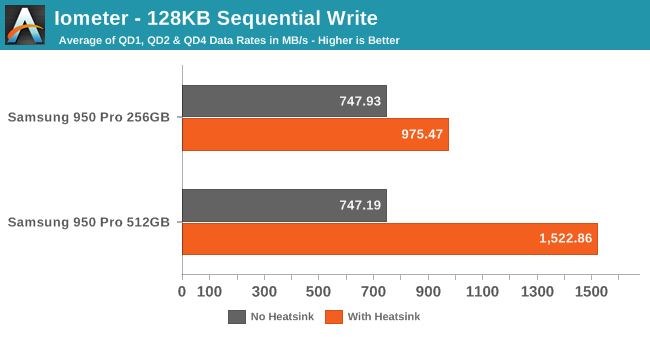
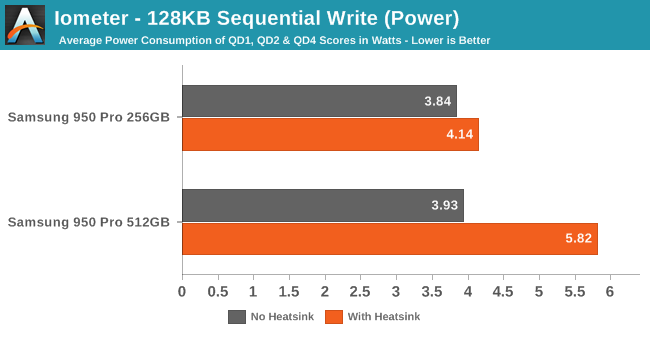
The heatsink provides a nice boost to the 256GB 950 Pro's sequential write speed, but doubles the sustained performance of the 512GB model. Power efficiency is still improved, especially for the 512GB drive, but it's now reaching almost 6W.
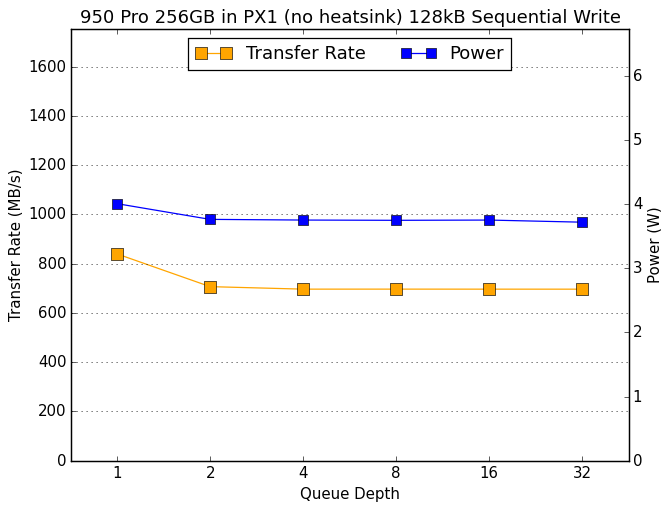 |
|||||||||
| 256GB no heatsink | 512GB no heatsink | ||||||||
| 256GB with heatsink | 512GB with heatsink | ||||||||
Without the heatsink, both drives experience thermal throttling only a few minutes into the test, with QD2 performance lower than QD1. With the heatsink, both drives show steady performance across the entire test. The 256GB improves QD1 performance slightly while the 512GB drive sees a 73% increase in QD1 performance. At queue depths greater than one the performance improvements are even larger.
Sequential Read
With the lower overhead of sequential operations and the inherent speed advantage reads have over writes, the sequential read test usually produces the highest throughput numbers. For SATA drives nowadays this usually means the SATA interface itself is the bottleneck, but even with NVMe we haven't seen a drive yet saturate the bandwidth of a PCIe 3.0 x4 link. Depending on the drive, this test could be limited by bottlenecks in the SSD controller's host interface or its connections to the flash memory.
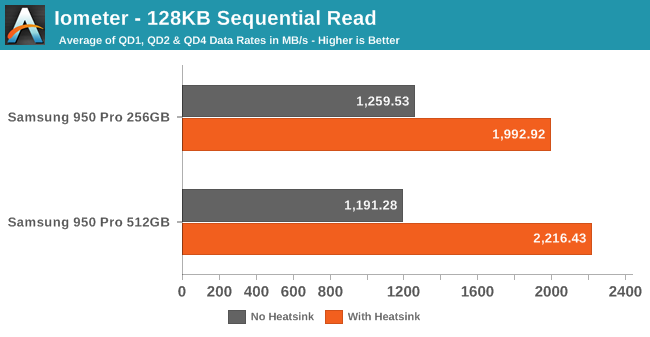

Both capacities see significant gains in sequential read performance, accompanied by smaller but still significant increases in power consumption. The 512GB drive once again manages to double sustained performance, and the 256GB improves by 58%.
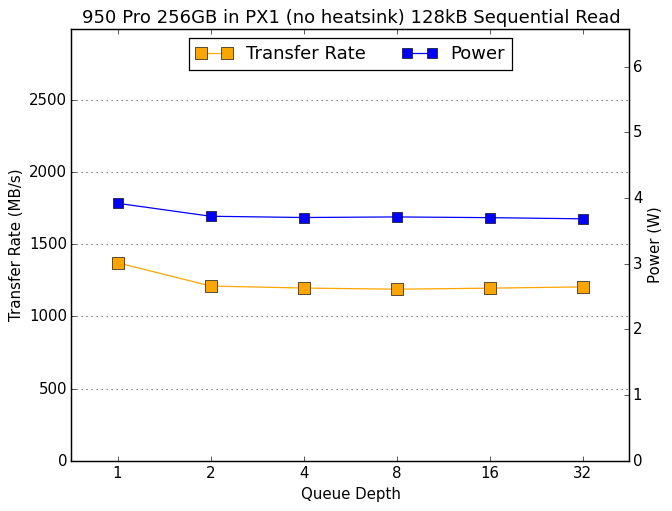 |
|||||||||
| 256GB no heatsink | 512GB no heatsink | ||||||||
| 256GB with heatsink | 512GB with heatsink | ||||||||
Again we see that the drives can't scale with higher queue depths when they're thermally constrained, but when properly cooled they perform superbly with any queue depth larger than one. The 512GB drive manages to deliver slightly more than 2.6GB/s read speed, well above what can be achieved with PCIe 2.0 x4 and about two thirds of the capacity of the PCIe 3.0 x4 link used by the 950 Pro.










69 Comments
View All Comments
Haravikk - Monday, December 21, 2015 - link
I think I could only see this being useful if you were building a system loaded with SSDs in the PCIe slots; in a system with a GPU I'd expect the extra heat from that will easily result in worse performance than keeping the M.2 drive on the motherboard.In fact, for a single M.2 SSD system my preference is a motherboard with an M.2 slot on the back; this keeps it away from the worst heat generating components, and even though few cases provide proper airflow on the back of the motherboard, as long as your cooling is adequate it should never get too hot for the drive.
Even if you are building a system with a ton of SSDs, the main benefit is having the PCIe adapter IMO, it doesn't seem like the heatsink makes such a big difference that you're ever really going to notice it.
vFunct - Monday, December 21, 2015 - link
This is going to be mostly useful in servers, where sustained (non-burst) read/write is typical.Ethos Evoss - Saturday, December 26, 2015 - link
Now new NVMe M.2 SSDs NEED heatsink totally bcos PCIe 3.0 x4 has very very high bandwidth and generates 100 C degrees celsius !Ethos Evoss - Saturday, December 26, 2015 - link
https://www.youtube.com/watch?v=d3GlInzvHr8frowertr - Monday, December 21, 2015 - link
Really think M.2 is the future. No cables and small size sounds like a winner to me.ImSpartacus - Monday, December 21, 2015 - link
It's probably the future, but it'll take a while to get there.If you need a cheap ssd for a boring boot drive, then 2.5" is the way to go if you have anything close to resembling a budget.
frowertr - Monday, December 21, 2015 - link
Yeah I agree. But they will figure out how to get more capacity at lower costs packed onto the size factor soon enough. I just built a new Skylake build for my living room HTPC/Xbox one look a like, and I used the Samsung EVO m.2 drive. What a refreshing piece of hardware. Just clipping it onto the motherboard like RAM and not dealing with any cables whatsoever made me feel like I was living in the future. Can't believe how far HDDs have come since I started building computers in the mid-90s.Lonyo - Monday, December 21, 2015 - link
The only reason consumer SSDs are 2.5" is because that's what the space is. If you had a 1.8" drive slot, and 1.8" drives, then SSDs would be smaller. They are the size they are because 2.5" was around for mechanical drives before SSDs, so it allows drop in replacement.The problem with M2 is that you end up having a space limitation because you need to free up space on the motherboard to put the thing, which means either you skip something else, or you have a larger motherboard, and then you aren't really saving any space anyway.
DanNeely - Monday, December 21, 2015 - link
Using the 1.8" HDD form factor probably would have impacted higher end drives in prior years. It only has 60% of the areal size of a 2.5" model; and until fairly recently most high performance/capacity SSDs; used a full size 2.5" PCB. The only ones that were using cut down boards that would fit into a 1.8" housing without needing shrunk were lower end budget models. While it doesn't matter much now (Samsung's 2tb models use smaller PCBs that look like they'd almost fit in the smaller form factor unchanged); cropping off the largest size from the market a few years ago would've probably hurt adoption.MrSpadge - Monday, December 21, 2015 - link
I fail to see a good reason why SSDs have to become more expensive if you remove their case. Anything on that M.2 card is also in a 2.5" drive, yet it's no problem to fit the components onto that small PCB (as long as you're not trying to make very large drives).